EAT240 Project: Automated Chilling Station Design and Implementation
VerifiedAdded on 2022/10/04
|12
|1655
|20
Project
AI Summary
This document details the design and implementation of an automated chilling station for a manufacturing process. The project involves developing a system to cool canisters of food based on their initial temperature, measured by a temperature sensor. The solution outlines the selection of a Negative Temperature Coefficient (NTC) thermistor, signal conditioning techniques, and interfacing with a PIC18F2455 microcontroller. The microcontroller program determines the chilling duration based on temperature readings and signals a Rockwell Micro 820 PLC to control the conveyor belt and solenoids. The PLC program manages the movement of canisters, the chilling process, and a counter for the number of processed canisters, triggering an alarm for refilling after 40 cycles. The solution includes system requirements, architectural diagrams, program code, and ladder diagrams for the PLC, showcasing a comprehensive approach to automation in manufacturing.
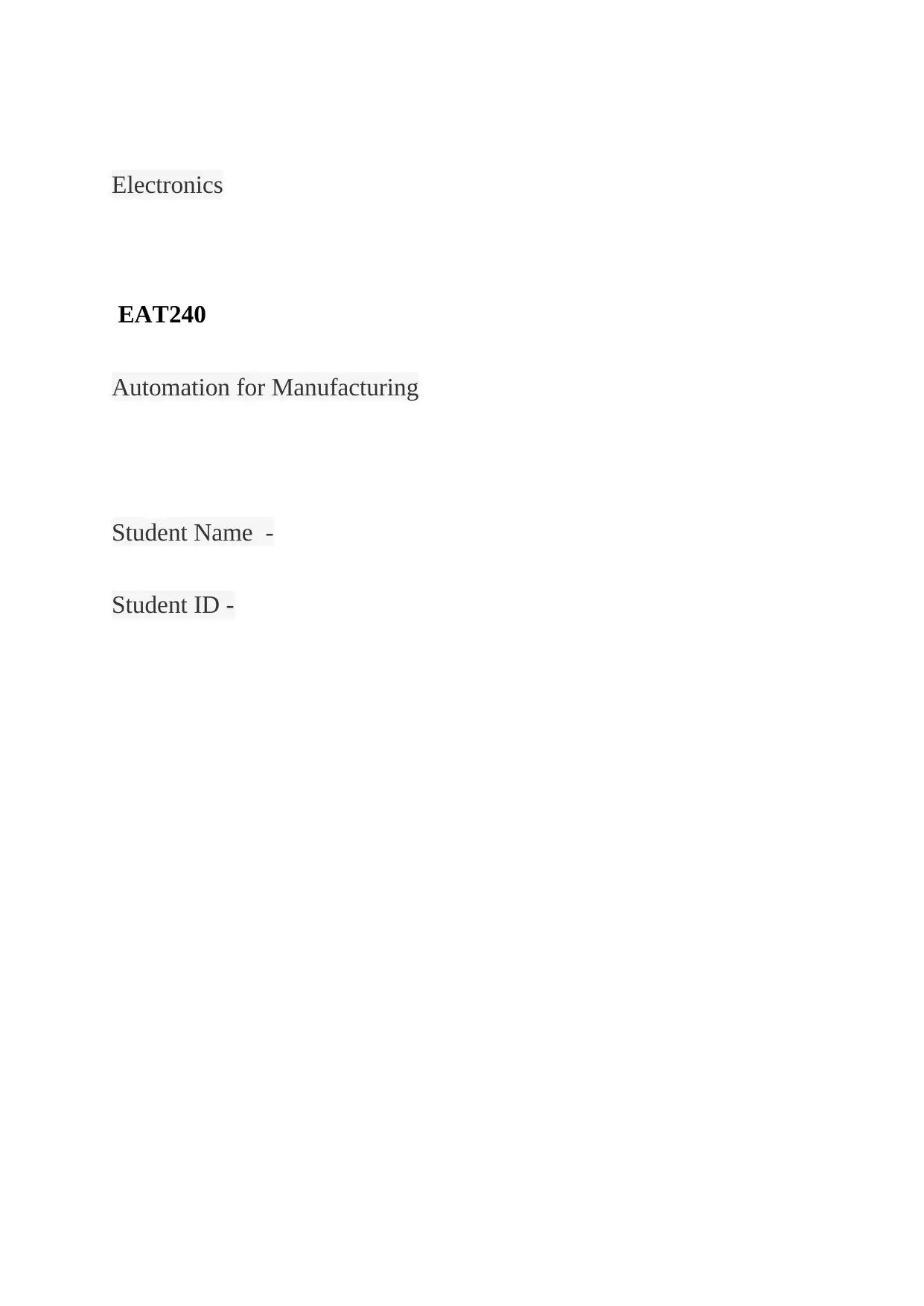
Electronics
EAT240
Automation for Manufacturing
Student Name -
Student ID -
EAT240
Automation for Manufacturing
Student Name -
Student ID -
Paraphrase This Document
Need a fresh take? Get an instant paraphrase of this document with our AI Paraphraser
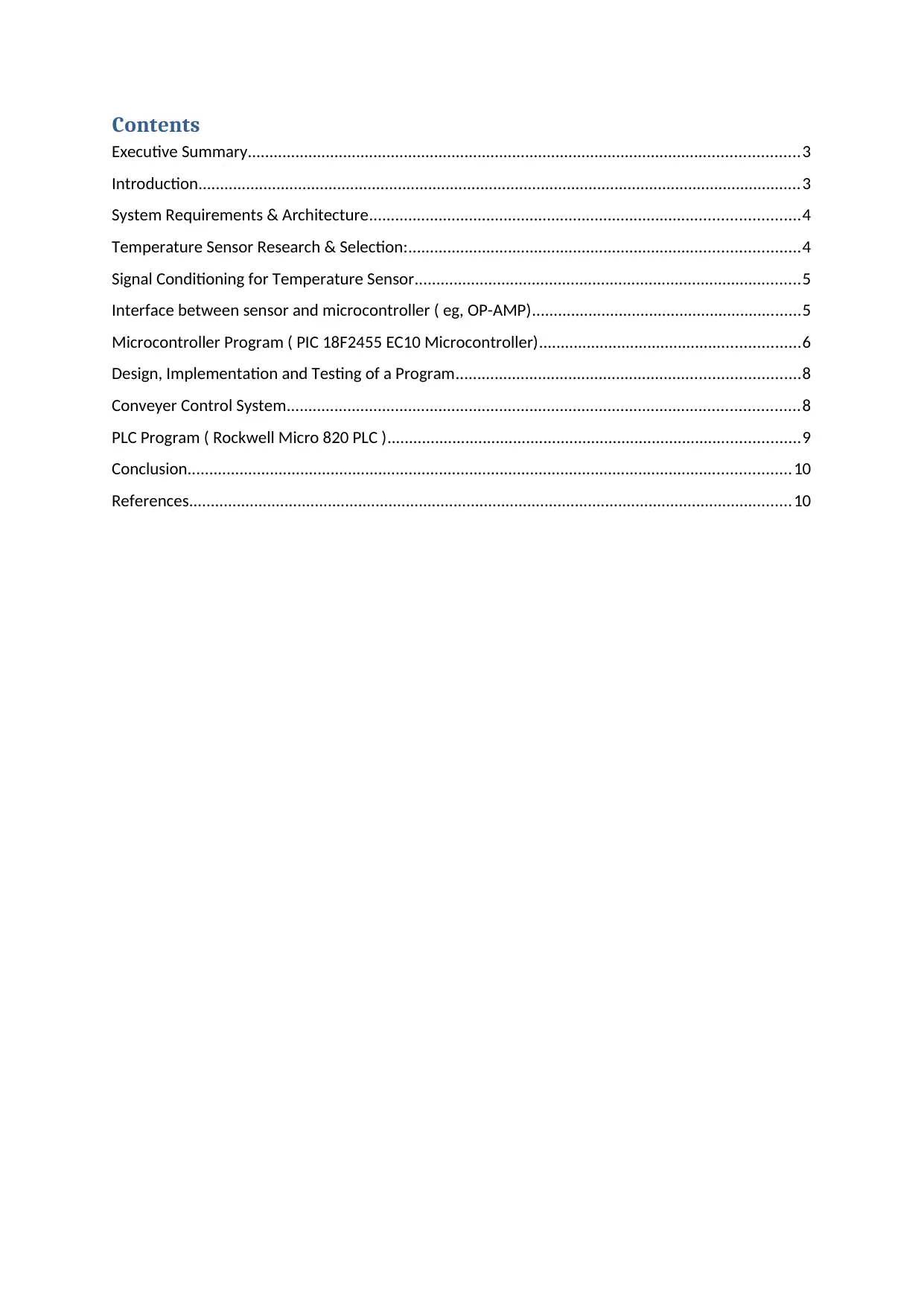
Contents
Executive Summary...............................................................................................................................3
Introduction...........................................................................................................................................3
System Requirements & Architecture...................................................................................................4
Temperature Sensor Research & Selection:..........................................................................................4
Signal Conditioning for Temperature Sensor.........................................................................................5
Interface between sensor and microcontroller ( eg, OP-AMP)..............................................................5
Microcontroller Program ( PIC 18F2455 EC10 Microcontroller)............................................................6
Design, Implementation and Testing of a Program...............................................................................8
Conveyer Control System......................................................................................................................8
PLC Program ( Rockwell Micro 820 PLC )...............................................................................................9
Conclusion...........................................................................................................................................10
References...........................................................................................................................................10
Executive Summary...............................................................................................................................3
Introduction...........................................................................................................................................3
System Requirements & Architecture...................................................................................................4
Temperature Sensor Research & Selection:..........................................................................................4
Signal Conditioning for Temperature Sensor.........................................................................................5
Interface between sensor and microcontroller ( eg, OP-AMP)..............................................................5
Microcontroller Program ( PIC 18F2455 EC10 Microcontroller)............................................................6
Design, Implementation and Testing of a Program...............................................................................8
Conveyer Control System......................................................................................................................8
PLC Program ( Rockwell Micro 820 PLC )...............................................................................................9
Conclusion...........................................................................................................................................10
References...........................................................................................................................................10
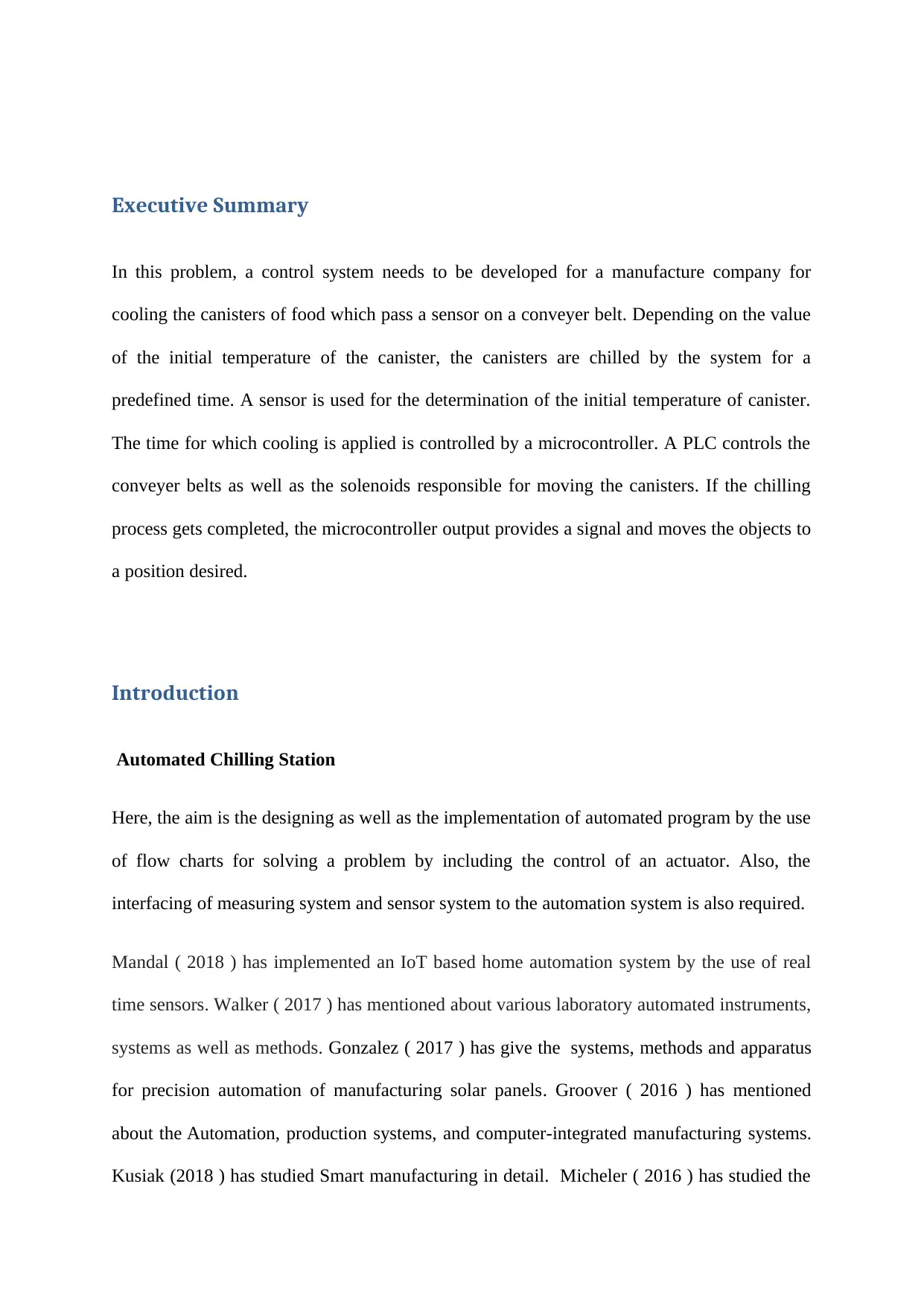
Executive Summary
In this problem, a control system needs to be developed for a manufacture company for
cooling the canisters of food which pass a sensor on a conveyer belt. Depending on the value
of the initial temperature of the canister, the canisters are chilled by the system for a
predefined time. A sensor is used for the determination of the initial temperature of canister.
The time for which cooling is applied is controlled by a microcontroller. A PLC controls the
conveyer belts as well as the solenoids responsible for moving the canisters. If the chilling
process gets completed, the microcontroller output provides a signal and moves the objects to
a position desired.
Introduction
Automated Chilling Station
Here, the aim is the designing as well as the implementation of automated program by the use
of flow charts for solving a problem by including the control of an actuator. Also, the
interfacing of measuring system and sensor system to the automation system is also required.
Mandal ( 2018 ) has implemented an IoT based home automation system by the use of real
time sensors. Walker ( 2017 ) has mentioned about various laboratory automated instruments,
systems as well as methods. Gonzalez ( 2017 ) has give the systems, methods and apparatus
for precision automation of manufacturing solar panels. Groover ( 2016 ) has mentioned
about the Automation, production systems, and computer-integrated manufacturing systems.
Kusiak (2018 ) has studied Smart manufacturing in detail. Micheler ( 2016 ) has studied the
In this problem, a control system needs to be developed for a manufacture company for
cooling the canisters of food which pass a sensor on a conveyer belt. Depending on the value
of the initial temperature of the canister, the canisters are chilled by the system for a
predefined time. A sensor is used for the determination of the initial temperature of canister.
The time for which cooling is applied is controlled by a microcontroller. A PLC controls the
conveyer belts as well as the solenoids responsible for moving the canisters. If the chilling
process gets completed, the microcontroller output provides a signal and moves the objects to
a position desired.
Introduction
Automated Chilling Station
Here, the aim is the designing as well as the implementation of automated program by the use
of flow charts for solving a problem by including the control of an actuator. Also, the
interfacing of measuring system and sensor system to the automation system is also required.
Mandal ( 2018 ) has implemented an IoT based home automation system by the use of real
time sensors. Walker ( 2017 ) has mentioned about various laboratory automated instruments,
systems as well as methods. Gonzalez ( 2017 ) has give the systems, methods and apparatus
for precision automation of manufacturing solar panels. Groover ( 2016 ) has mentioned
about the Automation, production systems, and computer-integrated manufacturing systems.
Kusiak (2018 ) has studied Smart manufacturing in detail. Micheler ( 2016 ) has studied the
⊘ This is a preview!⊘
Do you want full access?
Subscribe today to unlock all pages.

Trusted by 1+ million students worldwide
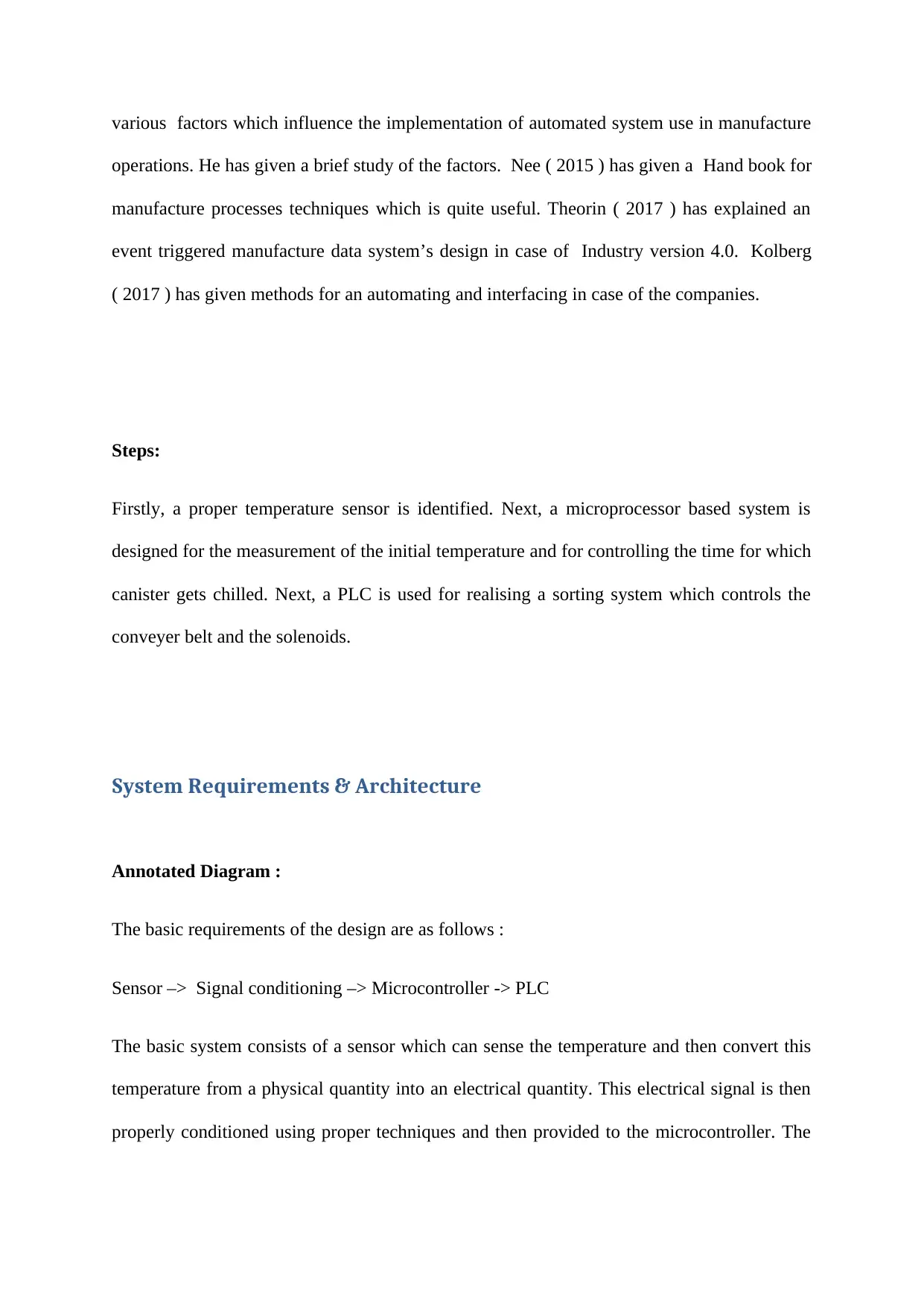
various factors which influence the implementation of automated system use in manufacture
operations. He has given a brief study of the factors. Nee ( 2015 ) has given a Hand book for
manufacture processes techniques which is quite useful. Theorin ( 2017 ) has explained an
event triggered manufacture data system’s design in case of Industry version 4.0. Kolberg
( 2017 ) has given methods for an automating and interfacing in case of the companies.
Steps:
Firstly, a proper temperature sensor is identified. Next, a microprocessor based system is
designed for the measurement of the initial temperature and for controlling the time for which
canister gets chilled. Next, a PLC is used for realising a sorting system which controls the
conveyer belt and the solenoids.
System Requirements & Architecture
Annotated Diagram :
The basic requirements of the design are as follows :
Sensor –> Signal conditioning –> Microcontroller -> PLC
The basic system consists of a sensor which can sense the temperature and then convert this
temperature from a physical quantity into an electrical quantity. This electrical signal is then
properly conditioned using proper techniques and then provided to the microcontroller. The
operations. He has given a brief study of the factors. Nee ( 2015 ) has given a Hand book for
manufacture processes techniques which is quite useful. Theorin ( 2017 ) has explained an
event triggered manufacture data system’s design in case of Industry version 4.0. Kolberg
( 2017 ) has given methods for an automating and interfacing in case of the companies.
Steps:
Firstly, a proper temperature sensor is identified. Next, a microprocessor based system is
designed for the measurement of the initial temperature and for controlling the time for which
canister gets chilled. Next, a PLC is used for realising a sorting system which controls the
conveyer belt and the solenoids.
System Requirements & Architecture
Annotated Diagram :
The basic requirements of the design are as follows :
Sensor –> Signal conditioning –> Microcontroller -> PLC
The basic system consists of a sensor which can sense the temperature and then convert this
temperature from a physical quantity into an electrical quantity. This electrical signal is then
properly conditioned using proper techniques and then provided to the microcontroller. The
Paraphrase This Document
Need a fresh take? Get an instant paraphrase of this document with our AI Paraphraser
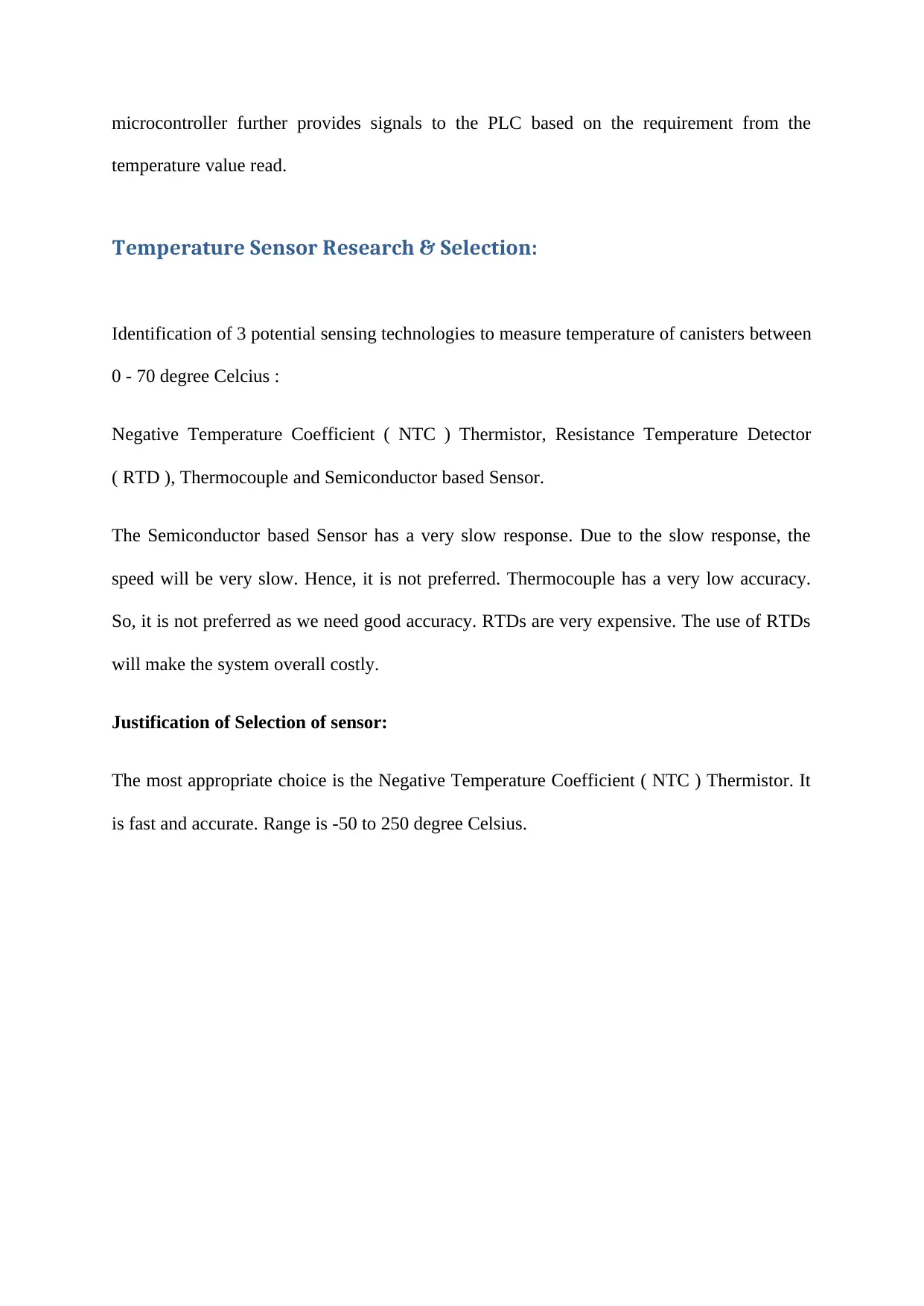
microcontroller further provides signals to the PLC based on the requirement from the
temperature value read.
Temperature Sensor Research & Selection:
Identification of 3 potential sensing technologies to measure temperature of canisters between
0 - 70 degree Celcius :
Negative Temperature Coefficient ( NTC ) Thermistor, Resistance Temperature Detector
( RTD ), Thermocouple and Semiconductor based Sensor.
The Semiconductor based Sensor has a very slow response. Due to the slow response, the
speed will be very slow. Hence, it is not preferred. Thermocouple has a very low accuracy.
So, it is not preferred as we need good accuracy. RTDs are very expensive. The use of RTDs
will make the system overall costly.
Justification of Selection of sensor:
The most appropriate choice is the Negative Temperature Coefficient ( NTC ) Thermistor. It
is fast and accurate. Range is -50 to 250 degree Celsius.
temperature value read.
Temperature Sensor Research & Selection:
Identification of 3 potential sensing technologies to measure temperature of canisters between
0 - 70 degree Celcius :
Negative Temperature Coefficient ( NTC ) Thermistor, Resistance Temperature Detector
( RTD ), Thermocouple and Semiconductor based Sensor.
The Semiconductor based Sensor has a very slow response. Due to the slow response, the
speed will be very slow. Hence, it is not preferred. Thermocouple has a very low accuracy.
So, it is not preferred as we need good accuracy. RTDs are very expensive. The use of RTDs
will make the system overall costly.
Justification of Selection of sensor:
The most appropriate choice is the Negative Temperature Coefficient ( NTC ) Thermistor. It
is fast and accurate. Range is -50 to 250 degree Celsius.
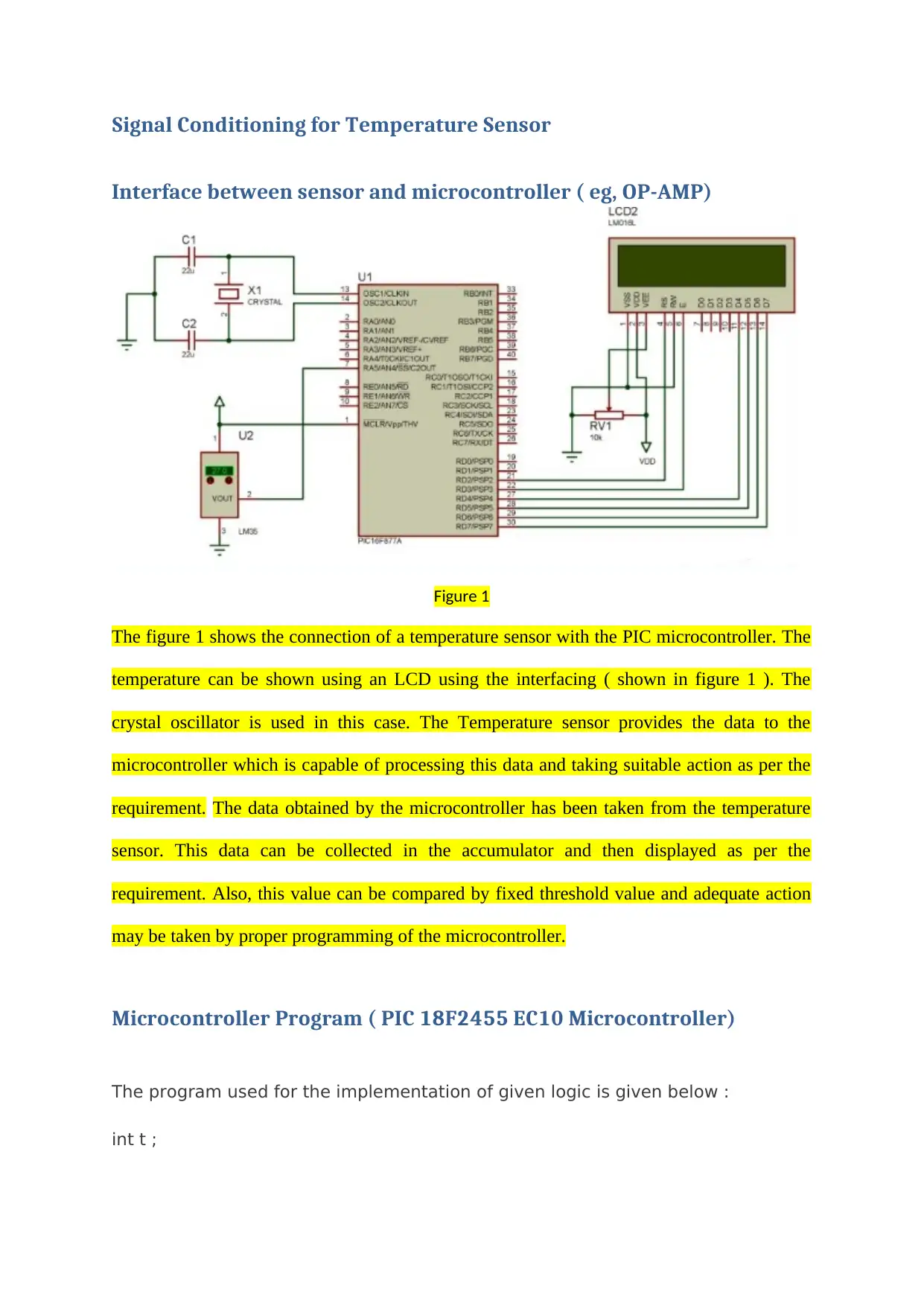
Signal Conditioning for Temperature Sensor
Interface between sensor and microcontroller ( eg, OP-AMP)
Figure 1
The figure 1 shows the connection of a temperature sensor with the PIC microcontroller. The
temperature can be shown using an LCD using the interfacing ( shown in figure 1 ). The
crystal oscillator is used in this case. The Temperature sensor provides the data to the
microcontroller which is capable of processing this data and taking suitable action as per the
requirement. The data obtained by the microcontroller has been taken from the temperature
sensor. This data can be collected in the accumulator and then displayed as per the
requirement. Also, this value can be compared by fixed threshold value and adequate action
may be taken by proper programming of the microcontroller.
Microcontroller Program ( PIC 18F2455 EC10 Microcontroller)
The program used for the implementation of given logic is given below :
int t ;
Interface between sensor and microcontroller ( eg, OP-AMP)
Figure 1
The figure 1 shows the connection of a temperature sensor with the PIC microcontroller. The
temperature can be shown using an LCD using the interfacing ( shown in figure 1 ). The
crystal oscillator is used in this case. The Temperature sensor provides the data to the
microcontroller which is capable of processing this data and taking suitable action as per the
requirement. The data obtained by the microcontroller has been taken from the temperature
sensor. This data can be collected in the accumulator and then displayed as per the
requirement. Also, this value can be compared by fixed threshold value and adequate action
may be taken by proper programming of the microcontroller.
Microcontroller Program ( PIC 18F2455 EC10 Microcontroller)
The program used for the implementation of given logic is given below :
int t ;
⊘ This is a preview!⊘
Do you want full access?
Subscribe today to unlock all pages.

Trusted by 1+ million students worldwide
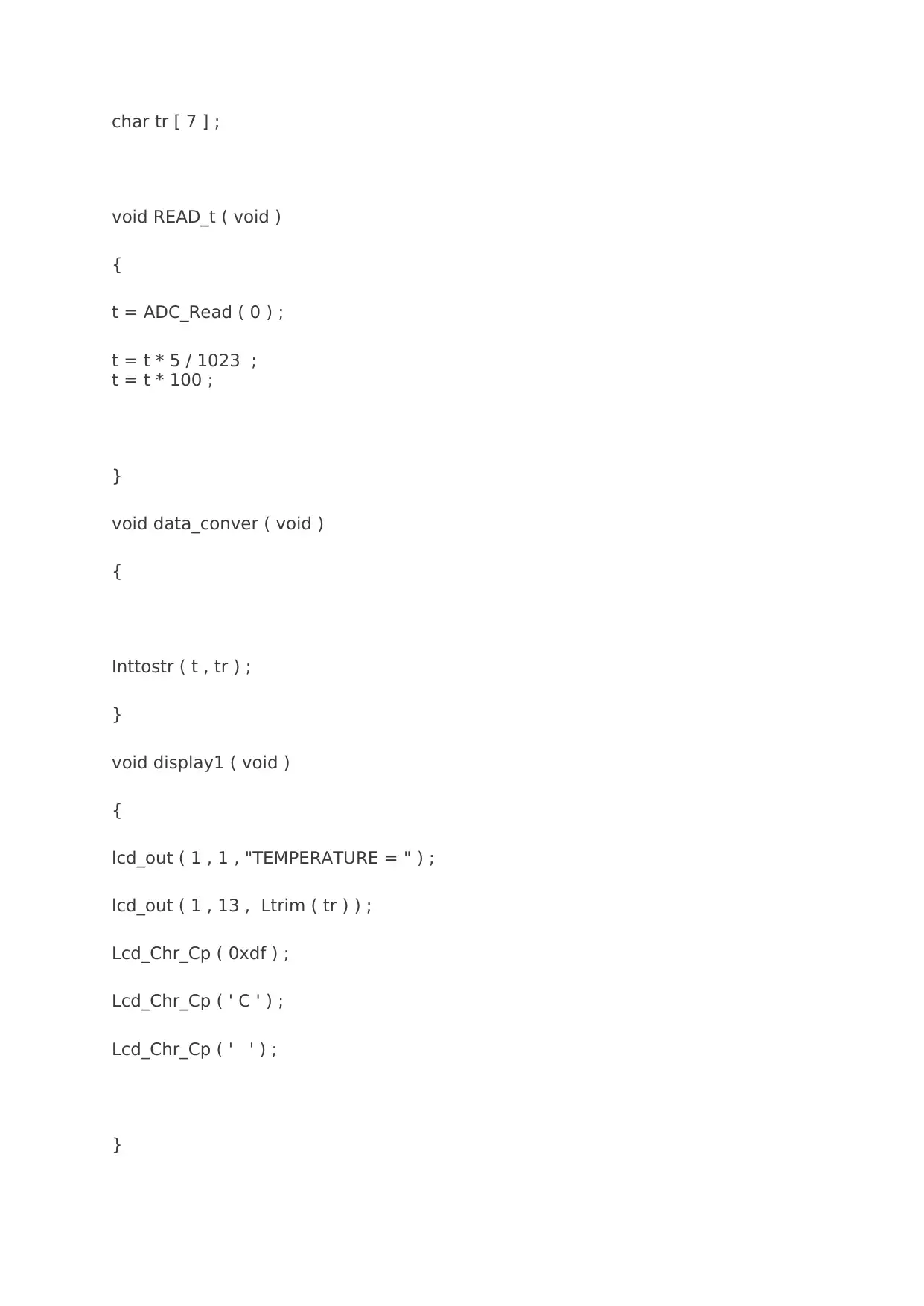
char tr [ 7 ] ;
void READ_t ( void )
{
t = ADC_Read ( 0 ) ;
t = t * 5 / 1023 ;
t = t * 100 ;
}
void data_conver ( void )
{
Inttostr ( t , tr ) ;
}
void display1 ( void )
{
lcd_out ( 1 , 1 , "TEMPERATURE = " ) ;
lcd_out ( 1 , 13 , Ltrim ( tr ) ) ;
Lcd_Chr_Cp ( 0xdf ) ;
Lcd_Chr_Cp ( ' C ' ) ;
Lcd_Chr_Cp ( ' ' ) ;
}
void READ_t ( void )
{
t = ADC_Read ( 0 ) ;
t = t * 5 / 1023 ;
t = t * 100 ;
}
void data_conver ( void )
{
Inttostr ( t , tr ) ;
}
void display1 ( void )
{
lcd_out ( 1 , 1 , "TEMPERATURE = " ) ;
lcd_out ( 1 , 13 , Ltrim ( tr ) ) ;
Lcd_Chr_Cp ( 0xdf ) ;
Lcd_Chr_Cp ( ' C ' ) ;
Lcd_Chr_Cp ( ' ' ) ;
}
Paraphrase This Document
Need a fresh take? Get an instant paraphrase of this document with our AI Paraphraser
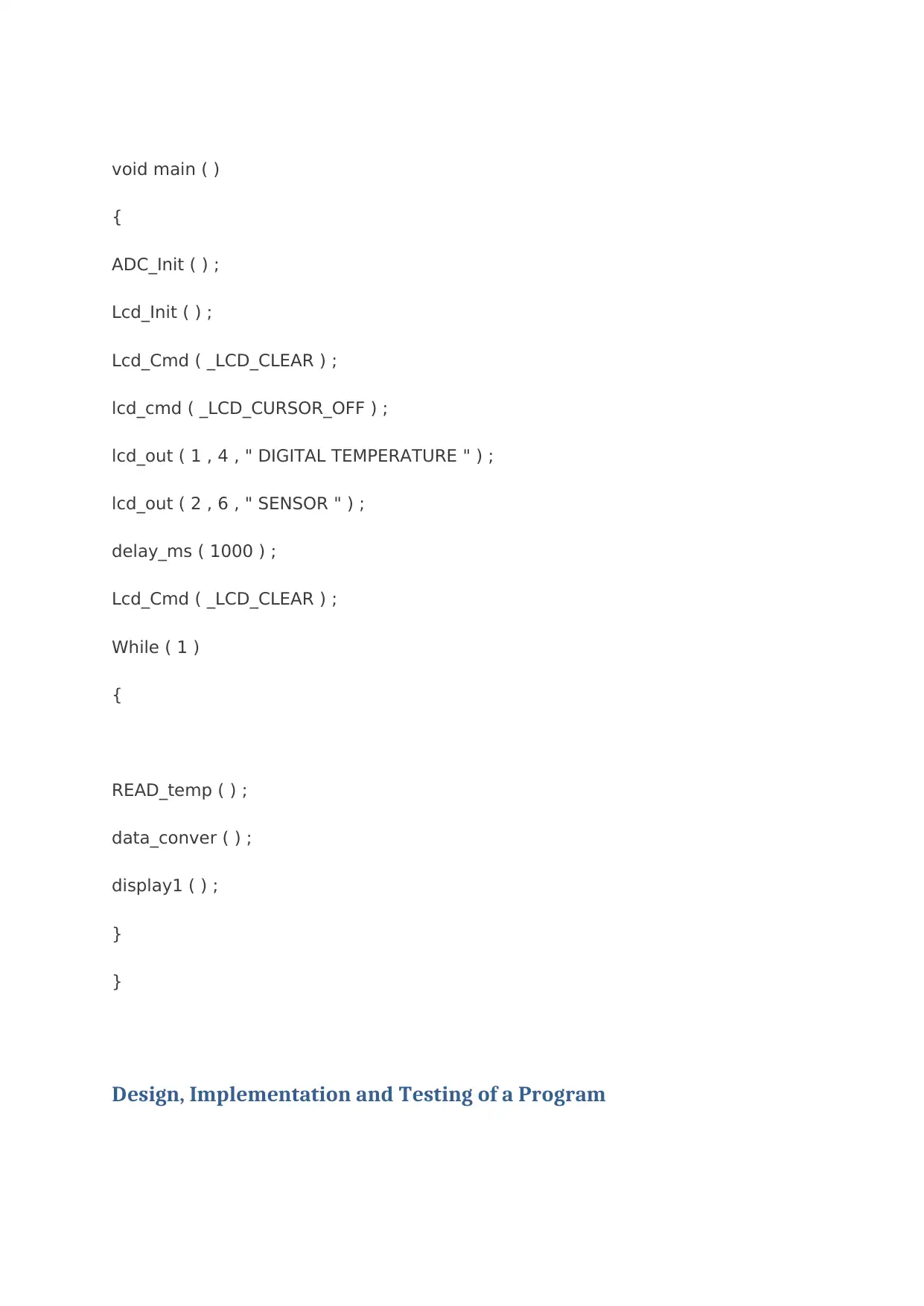
void main ( )
{
ADC_Init ( ) ;
Lcd_Init ( ) ;
Lcd_Cmd ( _LCD_CLEAR ) ;
lcd_cmd ( _LCD_CURSOR_OFF ) ;
lcd_out ( 1 , 4 , " DIGITAL TEMPERATURE " ) ;
lcd_out ( 2 , 6 , " SENSOR " ) ;
delay_ms ( 1000 ) ;
Lcd_Cmd ( _LCD_CLEAR ) ;
While ( 1 )
{
READ_temp ( ) ;
data_conver ( ) ;
display1 ( ) ;
}
}
Design, Implementation and Testing of a Program
{
ADC_Init ( ) ;
Lcd_Init ( ) ;
Lcd_Cmd ( _LCD_CLEAR ) ;
lcd_cmd ( _LCD_CURSOR_OFF ) ;
lcd_out ( 1 , 4 , " DIGITAL TEMPERATURE " ) ;
lcd_out ( 2 , 6 , " SENSOR " ) ;
delay_ms ( 1000 ) ;
Lcd_Cmd ( _LCD_CLEAR ) ;
While ( 1 )
{
READ_temp ( ) ;
data_conver ( ) ;
display1 ( ) ;
}
}
Design, Implementation and Testing of a Program
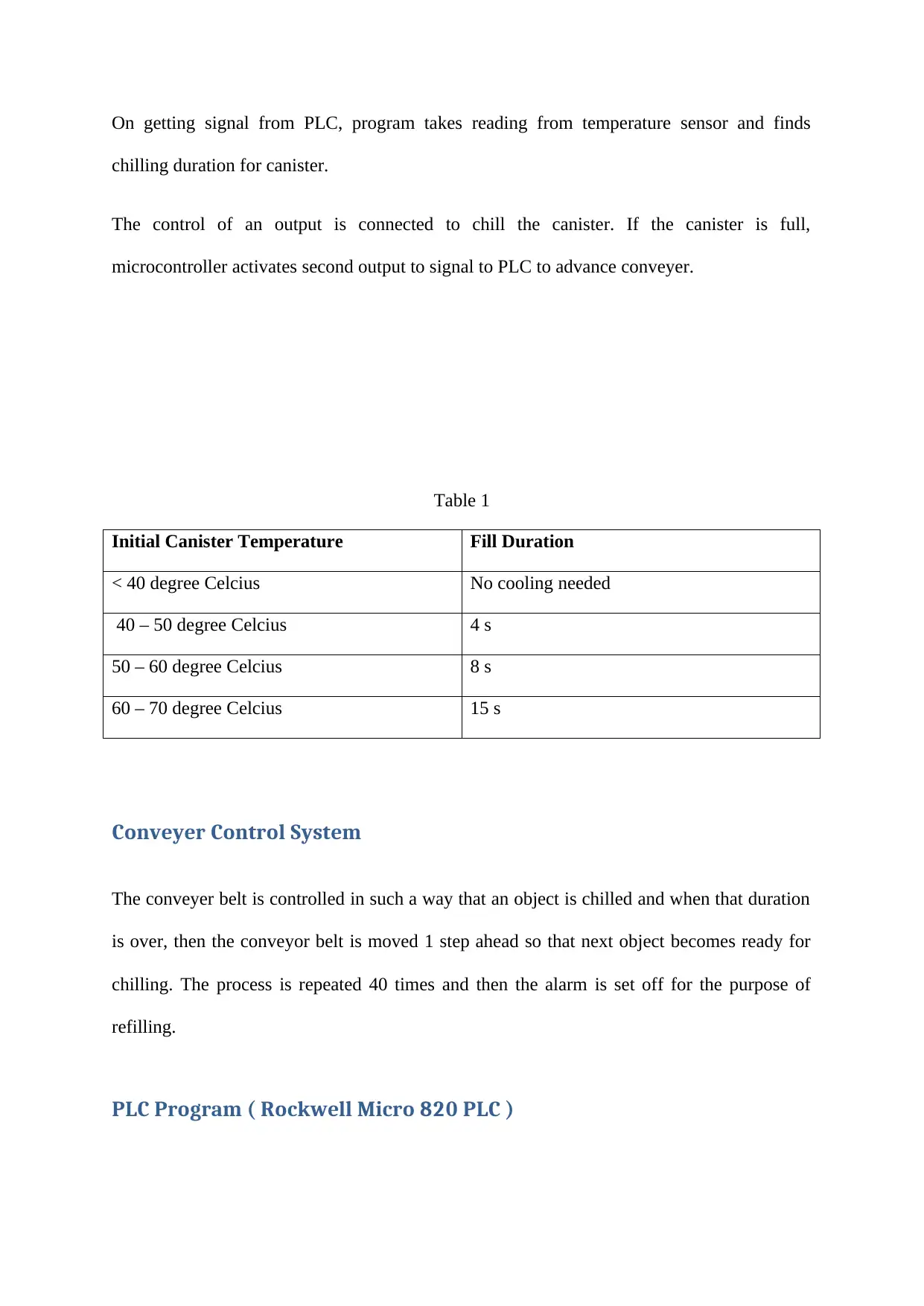
On getting signal from PLC, program takes reading from temperature sensor and finds
chilling duration for canister.
The control of an output is connected to chill the canister. If the canister is full,
microcontroller activates second output to signal to PLC to advance conveyer.
Table 1
Initial Canister Temperature Fill Duration
< 40 degree Celcius No cooling needed
40 – 50 degree Celcius 4 s
50 – 60 degree Celcius 8 s
60 – 70 degree Celcius 15 s
Conveyer Control System
The conveyer belt is controlled in such a way that an object is chilled and when that duration
is over, then the conveyor belt is moved 1 step ahead so that next object becomes ready for
chilling. The process is repeated 40 times and then the alarm is set off for the purpose of
refilling.
PLC Program ( Rockwell Micro 820 PLC )
chilling duration for canister.
The control of an output is connected to chill the canister. If the canister is full,
microcontroller activates second output to signal to PLC to advance conveyer.
Table 1
Initial Canister Temperature Fill Duration
< 40 degree Celcius No cooling needed
40 – 50 degree Celcius 4 s
50 – 60 degree Celcius 8 s
60 – 70 degree Celcius 15 s
Conveyer Control System
The conveyer belt is controlled in such a way that an object is chilled and when that duration
is over, then the conveyor belt is moved 1 step ahead so that next object becomes ready for
chilling. The process is repeated 40 times and then the alarm is set off for the purpose of
refilling.
PLC Program ( Rockwell Micro 820 PLC )
⊘ This is a preview!⊘
Do you want full access?
Subscribe today to unlock all pages.

Trusted by 1+ million students worldwide
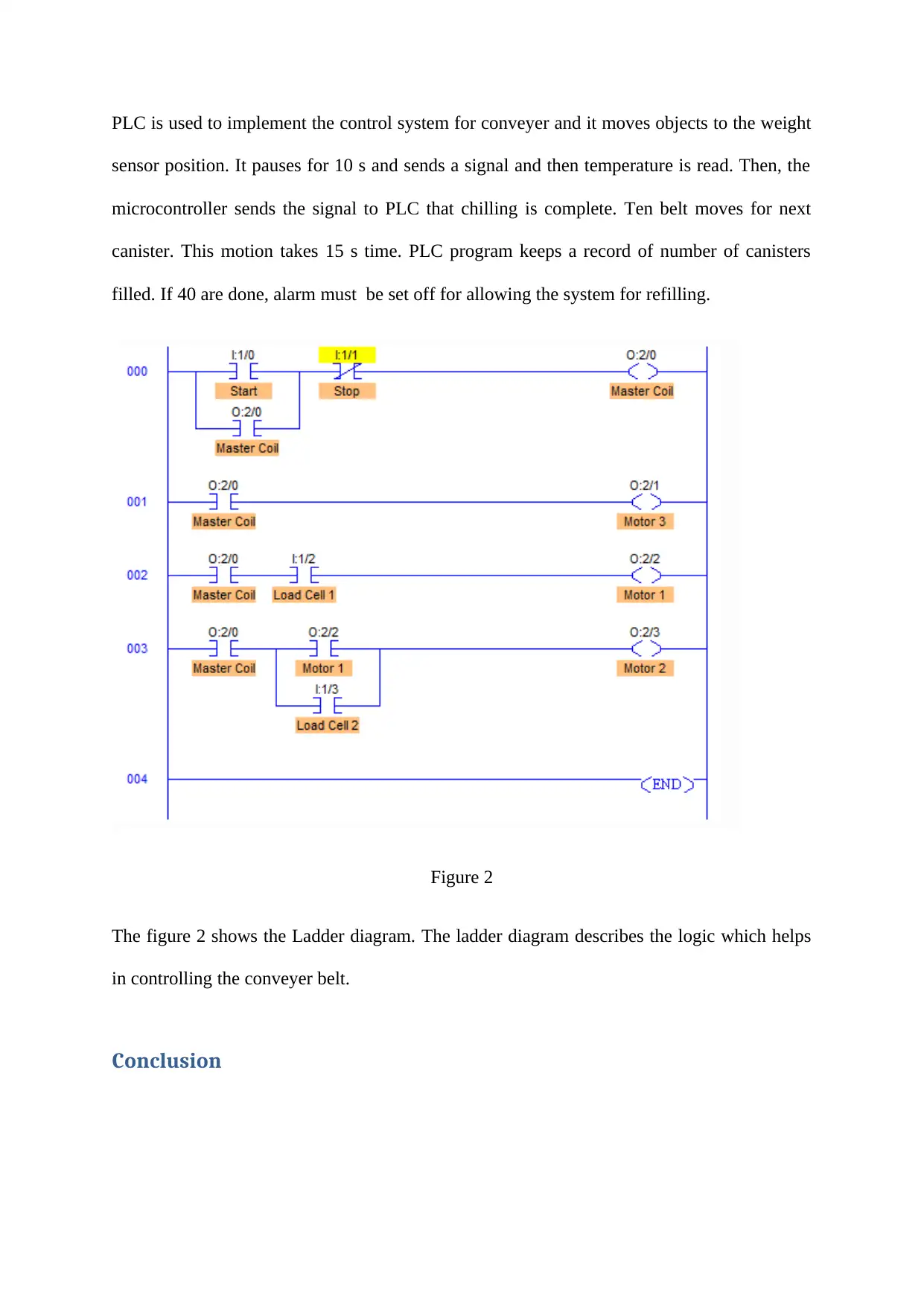
PLC is used to implement the control system for conveyer and it moves objects to the weight
sensor position. It pauses for 10 s and sends a signal and then temperature is read. Then, the
microcontroller sends the signal to PLC that chilling is complete. Ten belt moves for next
canister. This motion takes 15 s time. PLC program keeps a record of number of canisters
filled. If 40 are done, alarm must be set off for allowing the system for refilling.
Figure 2
The figure 2 shows the Ladder diagram. The ladder diagram describes the logic which helps
in controlling the conveyer belt.
Conclusion
sensor position. It pauses for 10 s and sends a signal and then temperature is read. Then, the
microcontroller sends the signal to PLC that chilling is complete. Ten belt moves for next
canister. This motion takes 15 s time. PLC program keeps a record of number of canisters
filled. If 40 are done, alarm must be set off for allowing the system for refilling.
Figure 2
The figure 2 shows the Ladder diagram. The ladder diagram describes the logic which helps
in controlling the conveyer belt.
Conclusion
Paraphrase This Document
Need a fresh take? Get an instant paraphrase of this document with our AI Paraphraser
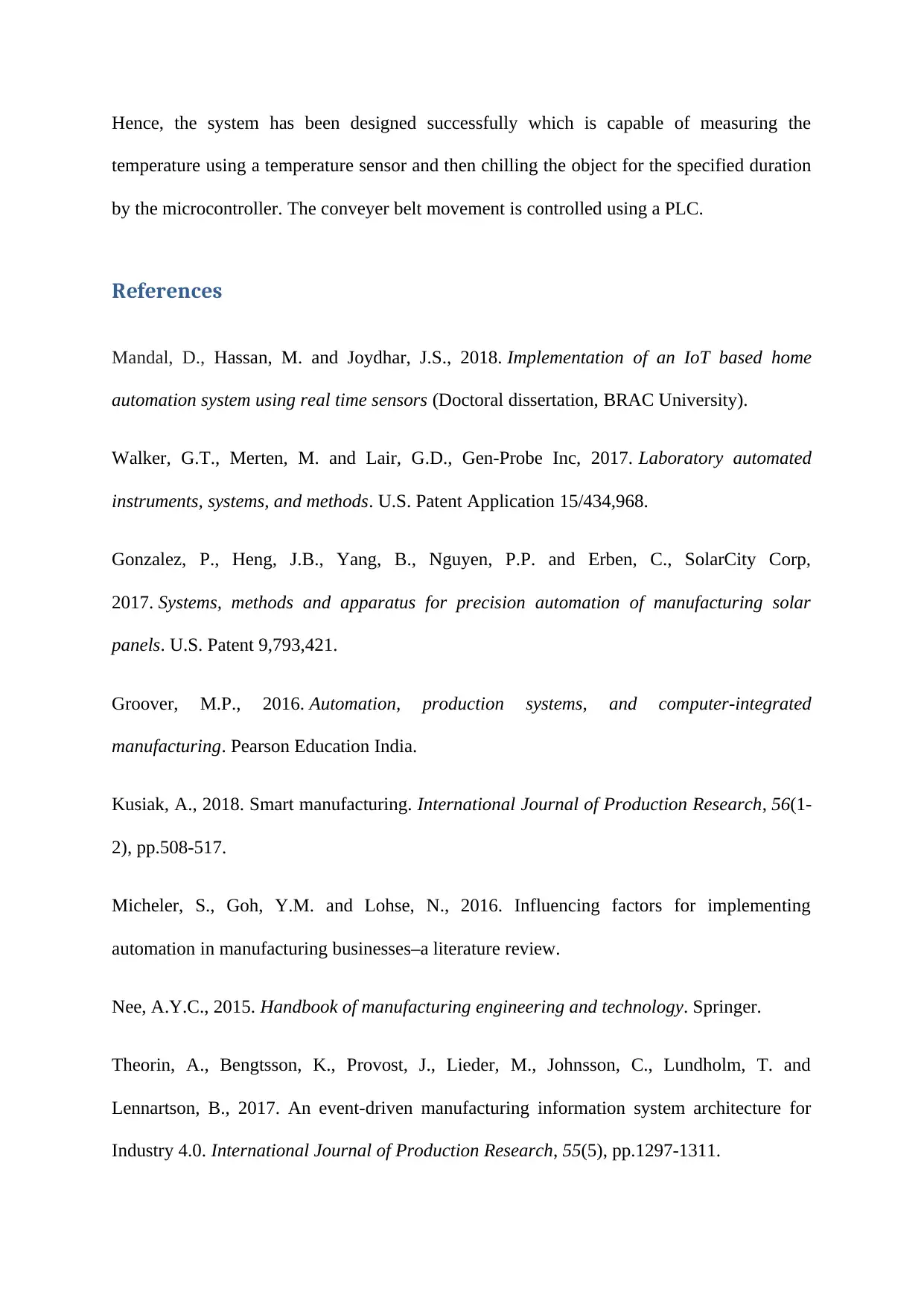
Hence, the system has been designed successfully which is capable of measuring the
temperature using a temperature sensor and then chilling the object for the specified duration
by the microcontroller. The conveyer belt movement is controlled using a PLC.
References
Mandal, D., Hassan, M. and Joydhar, J.S., 2018. Implementation of an IoT based home
automation system using real time sensors (Doctoral dissertation, BRAC University).
Walker, G.T., Merten, M. and Lair, G.D., Gen-Probe Inc, 2017. Laboratory automated
instruments, systems, and methods. U.S. Patent Application 15/434,968.
Gonzalez, P., Heng, J.B., Yang, B., Nguyen, P.P. and Erben, C., SolarCity Corp,
2017. Systems, methods and apparatus for precision automation of manufacturing solar
panels. U.S. Patent 9,793,421.
Groover, M.P., 2016. Automation, production systems, and computer-integrated
manufacturing. Pearson Education India.
Kusiak, A., 2018. Smart manufacturing. International Journal of Production Research, 56(1-
2), pp.508-517.
Micheler, S., Goh, Y.M. and Lohse, N., 2016. Influencing factors for implementing
automation in manufacturing businesses–a literature review.
Nee, A.Y.C., 2015. Handbook of manufacturing engineering and technology. Springer.
Theorin, A., Bengtsson, K., Provost, J., Lieder, M., Johnsson, C., Lundholm, T. and
Lennartson, B., 2017. An event-driven manufacturing information system architecture for
Industry 4.0. International Journal of Production Research, 55(5), pp.1297-1311.
temperature using a temperature sensor and then chilling the object for the specified duration
by the microcontroller. The conveyer belt movement is controlled using a PLC.
References
Mandal, D., Hassan, M. and Joydhar, J.S., 2018. Implementation of an IoT based home
automation system using real time sensors (Doctoral dissertation, BRAC University).
Walker, G.T., Merten, M. and Lair, G.D., Gen-Probe Inc, 2017. Laboratory automated
instruments, systems, and methods. U.S. Patent Application 15/434,968.
Gonzalez, P., Heng, J.B., Yang, B., Nguyen, P.P. and Erben, C., SolarCity Corp,
2017. Systems, methods and apparatus for precision automation of manufacturing solar
panels. U.S. Patent 9,793,421.
Groover, M.P., 2016. Automation, production systems, and computer-integrated
manufacturing. Pearson Education India.
Kusiak, A., 2018. Smart manufacturing. International Journal of Production Research, 56(1-
2), pp.508-517.
Micheler, S., Goh, Y.M. and Lohse, N., 2016. Influencing factors for implementing
automation in manufacturing businesses–a literature review.
Nee, A.Y.C., 2015. Handbook of manufacturing engineering and technology. Springer.
Theorin, A., Bengtsson, K., Provost, J., Lieder, M., Johnsson, C., Lundholm, T. and
Lennartson, B., 2017. An event-driven manufacturing information system architecture for
Industry 4.0. International Journal of Production Research, 55(5), pp.1297-1311.

Kolberg, D., Knobloch, J. and Zühlke, D., 2017. Towards a lean automation interface for
workstations. International journal of production research, 55(10), pp.2845-2856.
workstations. International journal of production research, 55(10), pp.2845-2856.
⊘ This is a preview!⊘
Do you want full access?
Subscribe today to unlock all pages.

Trusted by 1+ million students worldwide
1 out of 12
Related Documents
Your All-in-One AI-Powered Toolkit for Academic Success.
+13062052269
info@desklib.com
Available 24*7 on WhatsApp / Email
![[object Object]](/_next/static/media/star-bottom.7253800d.svg)
Unlock your academic potential
Copyright © 2020–2025 A2Z Services. All Rights Reserved. Developed and managed by ZUCOL.





